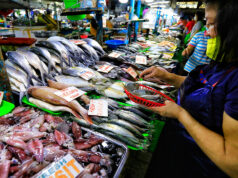April inflation seen further rising
By Melissa Luz T. Lopez
Senior Reporter
INFLATION likely accelerated further in April amid rising food and oil prices, with the impact of higher taxes and a weaker peso adding upward pressures to the cost of basic goods, according to a BusinessWorld poll.
A survey among 11 economists yielded a 4.5% median forecast for the month, which if realized will be higher than the 4.3% tallied in March and 3.2% in April 2017, using 2012 prices.

The Philippine Statistics Authority will report the latest inflation data on Friday.
Michael L. Ricafort, economist at the Rizal Commercial Banking Corp., said inflation could hover “at new five-year highs” this month given the impact of rising world crude rates; a surge in rice prices; a weaker peso-dollar exchange rate; and higher costs for cigarettes, alcohol, and sugary drinks due to tax reform.
Global oil prices hit a four-year peak this month, while short supply of cheap rice drove up prices of the staple in the market.
The peso also hovered at the P52-per-dollar level in April, leaving it as one of the worst performers when compared to other Asian currencies with year-to-date depreciation at 4.4%, Reuters reported.
ANZ Research economist Eugenia Fabon Victorino also pointed out higher electricity costs given the seasonal spike in rates during the summer as another factor to inflation.
Power distributor Manila Electric Co. announced a 22.5-centavo increase in utility rates this month due to a higher generation charge.
Inflation has averaged 3.8% as of end-March, just a tad below the 3.9% expected by the Bangko Sentral ng Pilipinas (BSP) for the full year and hovering close to breaching the 2-4% target band. Governor Nestor A. Espenilla, Jr. has said that the BSP is prepared to “take immediate and appropriate measures” to protect price and financial stability, as he finds comfort in knowing that the local economy can weather the impact of higher interest rates if needed.
Analysts expect prices to remain on an uptrend in the coming months, supporting views that it may be time for the BSP to raise borrowing rates to rein in inflation. In fact, several economists are pointing out that inflation is starting to look more broad-based given recent trends.
“A BSP rate hike in May 2018 may be prudent, as risks to inflation are clearly tilted to the upside even if we discount the impact of higher excise taxes,” said Guian Angelo S. Dumalagan, market economist at the Land Bank of the Philippines.
“While price increases in 2019 are likely to moderate, the magnitude of deceleration might be limited by factors that are likely to be more prolonged than transitory.”
The Monetary Board has kept policy rates at 2.5-3.5% last month, saying that inflation remains manageable despite being elevated. They added that current rates remain supportive of robust domestic economic activity, with indicators pointing to strong growth during the first quarter.
“We expect the Bangko Sentral ng Pilipinas to hike its policy rate by 25bp to 3.25% in Q2 to mitigate the second-round impacts of the tax reform and to curb rising inflation expectations,” global bank HSBC also said in a separate report, where it gave a 4.5% forecast for April.
In contrast, some analysts said the BSP still had some room to stay on hold.
Union Bank of the Philippines chief economist Ruben Carlo O. Asuncion said policy makers can even keep rates unchanged for the rest of 2018, with the recent upgrade from S&P Global Ratings signalling a vote of confidence.
The global debt watcher gave a “positive” outlook for the Philippines’ investment grade last week, hinting at a possible credit rating upgrade in the near term.
Angelo B. Taningco, economist at Security Bank Corp., added that first-quarter growth data due on May 10 will also affect the BSP’s policy review scheduled on the same day. Still, he added that there’s still a chance for a rate hike over the next two months.



